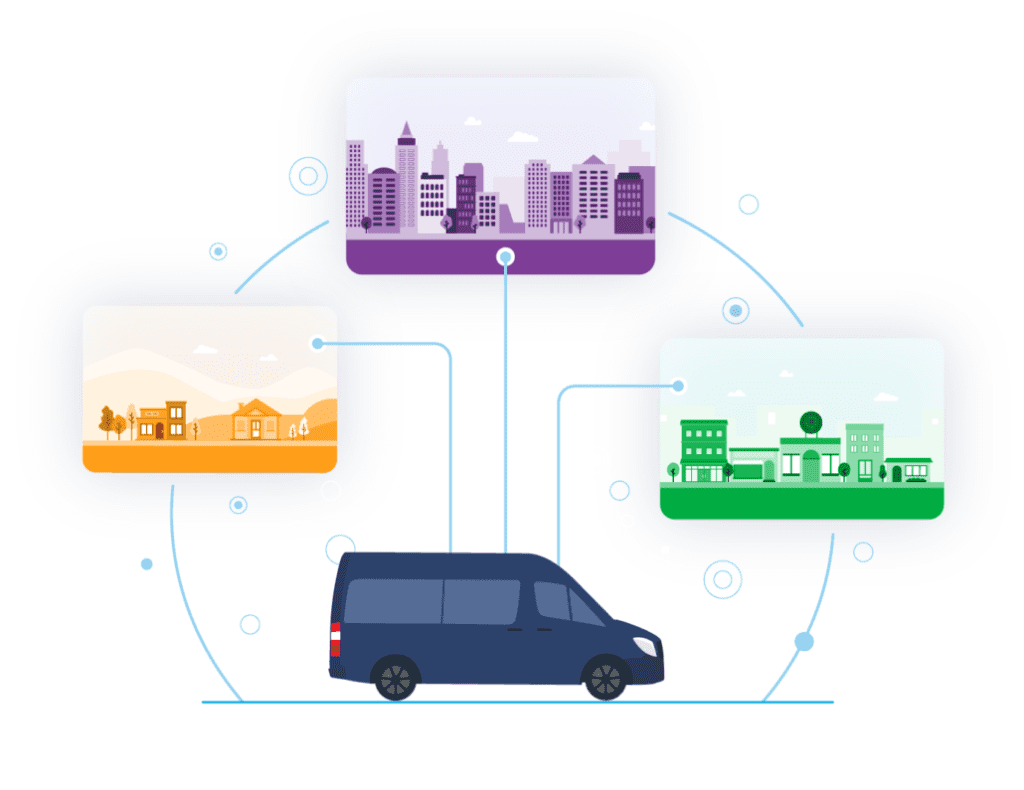Despite being relatively new, microtransits have quickly grown in popularity. As a result, the number of consumers has become higher than ever. Corporate workers and persons with disabilities have been especially receptive to the use of microtransit systems as their primary means of transportation due to their convenience and affordability.
Although microtransit’s popularity is indeed soaring high, it still hasn’t reached the level of private individual transportation such as Uber or Lyft. So, it’s only natural that there will be skeptics. If you’re one of them, then you’re probably wondering if it’s as promising as people make it out to be. If that’s the case, you can learn more about the pros and cons of microtransit systems below:
Pros
1. Expansive Service Coverage

You’ll often find public buses and trains in regions with a high population density. The same goes for private individual transportation. People in highly populated areas can order a ride from Uber just about anywhere within the city. But if you live in rural areas, you probably know the struggles of searching for a dependable mode of transportation. That’s about to change with microtransit systems.
This transit service is designed to serve as the primary means of transportation for low-income, low-population areas. Hence, it would solve your transportation problems once and for all. And since these systems have a much wider service coverage than public transportation, you’ll still be able to get a ride even if your destination is miles away from a bus stop. Of course, the coverage will mostly depend on the company, so you might want to check out Spare Labs for reliable microtransit solutions.
2. Lower Travel Times
Another difference you’ll notice between microtransit services and public transportation is that they use different kinds of vehicles. Unlike the big buses people are used to, microtransit systems deploy smaller and more compact vehicles, such as:
- Shuttles
- Street Cars
- Mini-buses
Now you might be wondering if this is truly an advantage. What you have to realize is that if the vehicle is smaller, there’ll be fewer seats, and fewer seats also equate to fewer stops. Hence, if the vehicle stops less frequently, you can arrive at your destination much faster. It’s also worth noting that microtransit vehicles are not always full, so there will be times where you’ll share the ride with only one or two passengers, further reducing the travel time.
3. Convenient Booking

In the past, using microtransit involved calling the agency using the telephone to order a ride. But nowadays, you only need to install an app and you can conveniently book a ride from there with just a few clicks. It’s just like how you order rides from Uber or Lyft. In addition to booking rides, you can also check more information about the vehicle, including:
- Arrival time
- Seating capacity
- Features
- Route
- Service coverage
By utilizing these pieces of information, you can quickly identify which ride will be ideal for your planned trip. The best part about this is that you can access these without additional fees.
4. Affordable
In some ways, microtransit shares similarities with private individual transportation. However, Uber rides are known to get pricey sometimes. So, you’re probably wondering if microtransit services are also as expensive as Uber?
Fortunately, the microtransit system isn’t as expensive. In fact, microtransit fares are often close to that of bus fares and train tickets, which is around USD$2 per trip.
5. Comfortable Trips

The main reason people like to order rides from Uber despite its price is that they can enjoy comfortable rides. The vehicle is spacious, you’re seated at all times, and, sometimes, there’ll be extra services like air conditioning. It’s a far cry to public buses and trains where it’s often crowded, and you sometimes find yourself up on your feet during the whole trip.
On the other hand, if you order a ride from a microtransit system, the spacious vehicles seldom run out of seats, so you don’t have to stand up. Simply put, you avoid the problems associated with public transit, you pay the same low prices as public buses, and you get to enjoy the comfortability of Uber rides at the same time.
6. Fewer Risks
Overloading is a common issue with public transportation, and while people don’t mind it too much, it’s a major issue that needs to be tackled as it can lead to many risks.
For starters, if you’re suffering from a health condition like asthma, you’re more likely to experience shortness of breath when you’re stuck in a crowded space. Moreover, you’re at risk of getting pick-pocketed.
7. Personalized Services

One of the most significant advantages of microtransit is that it caters to the individual needs of consumers. If an individual uses a wheelchair, they can opt for paratransit services—a subcategory of microtransit that provides services specifically to disabled persons by adding handrails and wheelchair ramps into their vehicles. These vehicles also pick up individuals directly from their houses, so there’s no need to go to bus stops.
8. Environmental-Friendly
The benefits of microtransit systems extend beyond transportation. This became apparent when a study by MaRSDD, a Canada-based corporation conducting researches on innovative technologies, shows that microtransit vehicles produce fewer gas emissions than typical vehicles. Experts believe this is because microtransit cars make fewer stops, so less fuel is consumed. Additionally, these vehicles’ routes are flexible, so drivers can take the shortest route possible, further reducing the vehicle’s gas emissions. Since the future of transportation involves minimal gas emissions, one can say that microtransit will grow into a major player in the coming years.
Cons
1. Certain Passengers Take More Time Than Needed

As previously mentioned, microtransit services also cater to special needs, so if one orders a ride from the system, the vehicle will wait for them even if they’re late. This can be pretty disadvantageous if you’re in a rush. There might be fewer stops, but if each stop takes a long time, then it’s no different from public transportation.
2. Some Companies Have Buggy Systems
You may also encounter certain microtransit companies that have buggy systems. This can lead to many issues, such as orders not going through the system or getting deleted for no reason. As a result, you may end up waiting for nothing. On the bright side, most microtransit systems have customer support, so you can try using that feature if you ever encounter any problems.
Wrapping Up

The concept of microtransit systems has been around for some time, but it only became widely popular due to the transport industry’s technological progress in the last few years. With that said, assuming the transportation industry continues to grow, microtransit systems are bound to improve and you can expect to benefit from these improvements. Most of its current disadvantages will be addressed by technological advancements catching up to customer demand and feedback.
 Imagup General Magazine 2024
Imagup General Magazine 2024



